4:30 Awards
The Yolanda Garcia Community Planner Award is presented to grassroots organizer and El Barrio activist Iris Morales.
The W. Allison and Elizabeth Stubbs Davis Award is presented to NYC Department of Parks & Recreation Chief of Operations Charles Gili.
3:40 Rebuild by Design with Mary Rowe (MAS), Julie Bargmann (D.I.R.T.), Mindy Fullilove (New York State Psychiatric Institute), Eric Klinenberg (Institute for Public Knowledge), Henk WJ Ovink (Hurricane Sandy Rebuilding Task Force)
MAS’s Mary Rowe moderates a discussion on Rebuild by Design, HUD’s multi-stage regionaldesign competition that will develop innovative projects to protect and enhance communities affected by Hurricane Sandy.
Henk WJ Ovink: The problem is so complex, we don’t know what it is. We design the process not to say “This is the problem, solve it,” but “What is the problem?” This is why we have a research phase.
Eric Klinenberg: We have to think about not building back, but building forward, pro-building for a region that’s facing the challenges we have. This is a unique and extraordinary opportunity to change how to relate to the environment and to use federal resources. If we do what we did after Hurricane Katrina or 9/11, we’ll be in trouble. This threat is just as real as 9/11 and if we address it with designers and planners alone, we’ll be in trouble. We need public participation.
Mindy Fullilove: The Rebuild by Design process has been a process of getting to know a region. There are so many threads of this process: there’s concentrated urban areas, there’s resort communities. The design sketchbooks allow us to see this all and that means we can be really informed as decision makers. Any little thing one town does will effect all the others; we need to be in concert.
In New Jersey we got hit by Sandy, Snowtober, Nemo—it really was a tipping point for us and the federal government was there. I really think we can do this together; I’m all in.
Mary Rowe: The scope of Rebuild by Design is not about jurisdictions.
Julie Bargmann: I’m anti-stuff; I want a process. We need a holistic approach.
3:15 Urban Water with David Maddox (The Nature of Cities), P. K. Das (P.K. Das & Associates), Susannah Drake (DLANDSTUDIO), Roland Lewis (Metropolitan Waterfront Alliance), Jay Valgora (Studio V)
Susannah Drake: I want to think about how we might combine ecological systems with social systems. The Gowanus Canal is an EPA Superfund site—it’s kind of my favorite cesspool. We’re trying to make the ground more absorptive to soak up some of the water while using plants to phyto-remediate the toxins in the water. We’re also creating a public open space that is a functional landscape.
P.K. Das: Being the backyard is being the dumping ground in physical and metaphorical terms. People participating in urban design issues is becoming an important aspect of urban planning.
Jay Valgora: This is the problem of our time: to take the leftover spaces, the gaps, the edges and to create new lives for them. We’re taking Civil War-era coffee houses that have been abandoned for a century and creating office and recreational spaces overlooking the Manhattan-Brooklyn waterfront.
Roland Lewis: My favorite word is “and.” There is 520 miles of waterfront and there is room for lots of experimentation and uses. Bloomberg says this is just the beginning; we’ve laid the bones for a transformation of the waterfront and I think he’s exactly right.
Think about the waterfront as a utility and that utility is owned by hundreds of stakeholders.
JV: We need to give elective guidelines for best use of the waterfront.
P.K. Das: Public is the citizens, not just the government.
2:55 The Nature of Cities with David Maddox (The Nature of Cities), Marielle Anzelone (Urban Ecologist), P. K. Das (P.K. Das & Associates), Timon MacPhearson (The New School), Richard Scott (Landlife)
Marielle Anzelone: We define cities badly; we define them as all cities and hardscapes. NYC has more forests, marshes, and meadows than any other city in America, but this nature is largely ignored. We need to save forests in New York City.
I’d like to start by reinventing the street tree. What is we took that tree and made it into a natural community surrounded by ferns, and shrubs, and wildflowers? What if we took 20 of these communities and snuck them into Times Square? If a forest can make it in Times Square, it can make it anywhere. If we put these forests on every city, we have habitats for warblers and monarchs. It’s important for public health: greenery makes us happier, healthier, and smarter.
Timon MacPhearson: Vacant lots are already being used by city residents as informal parking lots, as playspaces, etc. New York is a very dense city so there are a lot of challenges as to where to put something. But we should think about the way these vacant spaces can be transformed to meet the needs of the communities that are underserved by green spaces. Vacant lots are often associated with crime and danger but they have enormous potential for recreation, contemplation, neighborhood meetups, environmental needs, and stormwater management. We need to think about ecological function and social justice at the same time.
P.K. Das: I’m using the mapping process as an instrument for public dialogue and instigating public participation. Climate and architecture need to be tools for social change.
2:45 Confronting the Edge: Hudson River Park with Madelyn Wils (Hudson RIver Park Trust)
After Sandy, Hudson River Park spent $30 million in repairs. 10 miles of electric cable was repaired or replaced, 8,820 plants and, shrubs, and trees were planted, and 80 tons of top soil was renewed.
Wils explains that” People had the good sense 15 years ago to rebuild the park in concrete and build it for 50-100 years and because of that the piers could survive a storm like Sandy and the will survive in the future.”
2:35 Interventional Logic: The Brooklyn Bridge & 100 Fountains with Scott Francisco (Pilot Projects)
Designer, strategist and educator Scott Francisco speaks about the intersection of landmark and rainforest conservation. He is currently working with MAS and the Wildlife Conservation Society to use wood from endangered Brazilian rainforests to rebuild the Brooklyn Bridge.
2:25 Participatory Platforms for Resilience with Luigi Ferrara (Institute Without Boundaries)
Luigi Ferrara discusses strategies for using the public to collect valuable data, focusing on the “sense it, see it, make it” model used in Dublin.
“The citizens engaged in data missions,” he says. “An enthusiastic amateur has more commitment than any staff; if it shared that knowledge back with the dashboard, then the citizens could make decisions.” A system of including an app, a website, and a bus for public repairs could save $2 million a year in maintenance alone. “It’s elective participation. It was Draconian. It wasn’t big data,” explains.
He concludes by reminding us that “A city is resilient because the public is involved and working to solve the problems of the city.”
2:15 Penn and Beyond: SHoP with Vishaan Chakrabarti
Vishaan Chakrabarti discusses a space between the subway exit and the new Penn Station as comparable to the space between the subway exit and the Barkley’s Center, which SHoP also designed: “It’s wonderful to be able to come out of the train station and understand where it is in space rather than wearing it as a hat.”
He argues that “Our train stations are very important but we now have a very different kind of city where we live and work all over. We’re now creating offices in Seward Park…the idea of offices space on the LES was absurd 10 years ago.
He also refers to SHoP’s designs for the old Domino Sugar factory. “We will have more people working on this site than were working there at Domino in 1960 by a factor of two. People will bike and walk work!”
He concludes by arguing, “This is the city that we could be. Not just with the new Penn Station but with this new network of neighborhood where people live, work, and play in a more decentralized way.”
2:05 The DNA of the Mixed-Use Urban Super Block: Tokyo to NYC with Jonathan Marvel (Marvel Architects)
Jonathan Marvel argues that existence will become more and more vertical and asks “How do we mitigate verticality?” We should think about mixed use.
He says: “Tokyo is the birth place of the high-density, mixed-use typology that we’re now seeing all over the world. The DNA of the Japanese aesthetic is built into early mixed-use design.”
1:55 Remixed Use with Shohei Shigematsu (OMA)
Architect Shohei Shigematsu discourages what he calls the “bento box model” of mixed use design (below), in which uses are separated and segregated. He believes mixed use buildings can be far more interesting, bringing several uses into contact with each other to form a more integrated environment.

1:30 In Conversation: Darren Walker (Ford Foundation) and James Traub (foreignpolicy.com) on the Just City
James Traub: Is equity one of those things that the more you try to achieve it directly, it eludes you?
Darren Walker: No! No one is saying that inequality has to be eradicated but we should all be alarmed by the level of inequality in New York. It is regretable, tangibly, because it is harmful to democracy. opporutnity ladder, mobility escalator that everyone can get on…when the facts invalidate that narrative, it is harmful to our democracy.
JT: Harlem. The community of Harlem has succeeded, but the people are being displaced. How to you balance the force of dynamic growth which brings people in and the need not to displace the people who were already there?
DW: We used to say “If Lenox Avenue becomes Columbus Avenue, will Harlem still be Harlem?” The answer is “No.” When I lived in Harlem in the early ’90s you wouldn’t see a white woman by herself at 10:00 at night on the 2 train at 135th Street. Now you do and I actually think that’s great. And most people in Harlem think that’s great. Harlem also has public housing, tax credit housing, senior housing. It’s true that there has been displacement, but as far as urban revitalization efforts go, Harlem has been a huge success.
I don’t think the problem that Harlem is becoming less black is a problem. I think there’s a cultural identity that Harlem uniquely holds in the cultural identity in this nation; we don’t want to use that. That’s part of our American fabric. It’s not a racial thing; it’s part of our cultural narrative and that’s what’s so exciting.
JT: What is Ford doing for affordable housing?
DW: There have to be policies. The intersection of the market and policies makes it very, very hard without public intervention. We need more Section 8 housing locally, more tax credits to public developers to make it more possible for them, more public-private partnerships.
12:00pm: Mather Building Arts & Craftsmanship High School
Larry Gabbard, Founding Principal, Stephen T. Mather Building Arts & Craftsmanship High School
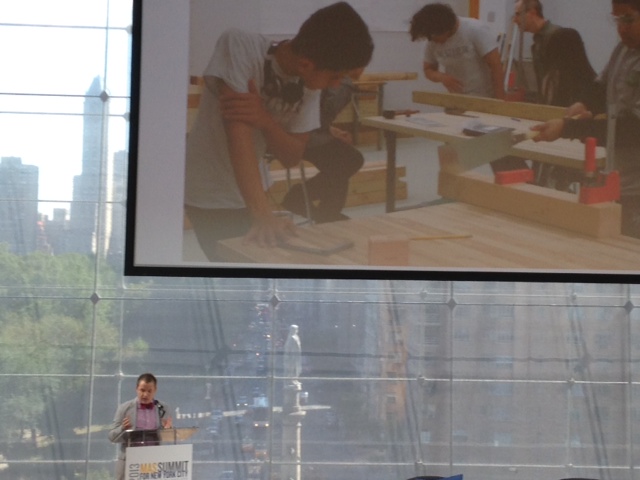
CTE Prepares students for the world of work but unlike vocational education programs of the past, this model provides students a college prep program while also teaching trades. Prepares them for college and career. Students learn foundational building arts skills like masonry, carpentry, lanscaping and go on to do internships. The study of the larger context of the trades also distinguishes Mather because it centers on preservation. The students take walking tours as part of their classes. Mather was conceived by the National Parks Service. The field of preservation requires specialized skill sets which have been shrinking while the need to care for aging structures and landscapes increases.
The Zone Model and The Future of NYCHA
11:45am Sideya Sherman, Director of Resident Economic Empowerment & Sustainability, New York City Housing Authority and Fred Harris, executive VP for Real Estate Development
Sideya Sherman
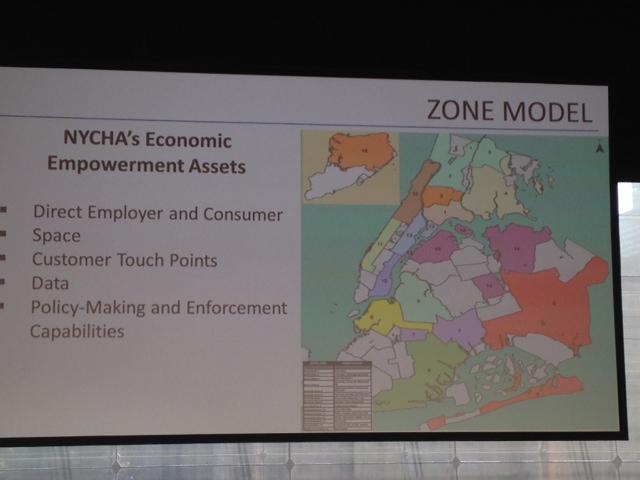
“NYCHA is a city within a city. We serve half a million NYers… NYCHA really contributes to the economic backbone of NYC…. but there’s low participation in services that help people get into the workforce.” NYCHA has shrinking resources and so the agency has started thinking about how to leverage non-financial assets.
How NYCHA Defines Success:
1. Ability to connect residents to services. They’re using a web-based program now to do things like rent adjustments.
2. Supporting providers to provide better services. They’re training
3. Attract resources to under-resourced communities.
4. Generating economic opportunity. They’re creating jobs and leveraging training by having a training academy for construction, pest control, etc in order for NYCHA to employ their own residents.
Fred Harris
How can we address NYCHA’s capital needs by leveraging its land?
3200 Market rate and 800 permanently affordable apartments could be built just on NYCHA’s spare land. It would be privately funded. NYCHA’s developments were built as towers in the park which they now see as a problem. To solve it: “We looked for only sites located on the perimeter. 11/14 sites are parking lots.” They seek to bring back the feeling of the grid to NYCHA neighborhoods.
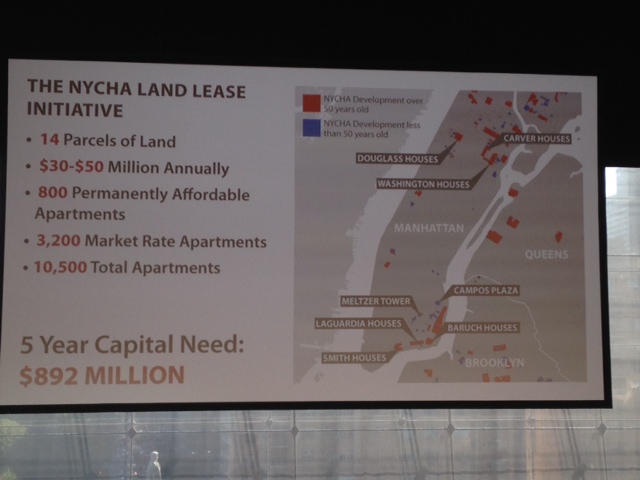
11:30am:The Politics of Public Space
Richard Sennett, Professor of Sociology, New York University and the London School of Economics and Political Science, Jerold Kayden, Professor, Harvard University
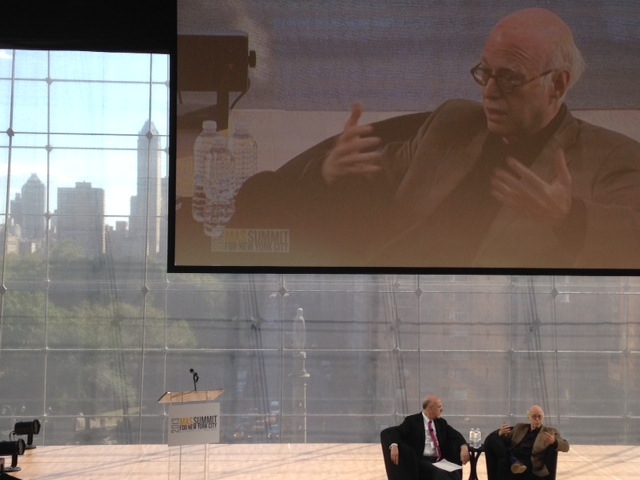
RS: “We are at a moment where a public space is both a social and physical space and we’re going to have an enormous change in what we think about public space and what it should do. We have regained a lot of physical public space but lost a lot of public space in the other sense, where people who are different economically meet for a purpose other than shopping. I think that’s why this two cities idea represents something very real which is that we are losing the public realm in NYC in which people who are different interact. My worry is, what can we do to restore that? Can physical planning foster social interaction?”
JK: “Do we have adequate public spaces for people to gather? I don’t think we do. We used to have the idea of the community center. One problem is that our communities are too income segregated for these sorts of things to attract city-wide.” He gives Central Park as a public space with economic diversity.
RS: Tells about growing up in Cabrini Green and how masses of poor kids needed to use the Hull House Settlement House. It served one of the poorest communities in Chicago on the edge of the Gold Coast. Hull House still is the model for him for institution building: a shared space that doesn’t just belong to one group of people and serves many different purposes.
JK: “We need to be more intentional about inviting people to come. We need to program and create activities that entice people… It would be fun to have a steward of public space, a curator, a programmer, that encourages people to come in. That might be more than encouraging it to come in spontaneously.”
RS: “In the West we’ve taken density for granted since the time of Haussman. You don’t have to concentrate people in a space in order to mix them together. I think we can learn from third world countries. This whole issue about public space, where it is, how many people are in it, has got to be rethought. This is a time to really think about what it is to make NYC a more public city. We’re at a good moment.”
11:00am: Keynote Commissioner Janette Sadik-Khan, Commissioner, New York City Department of Transportation
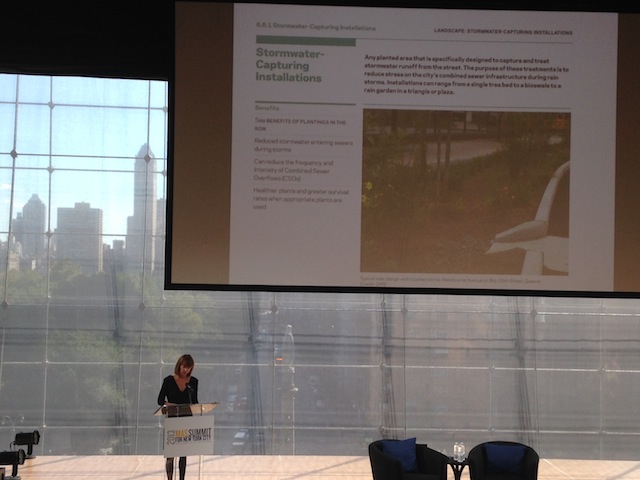
“If you care about the quality of our streets, you’ve seen the changes that we’ve made over the past six years… Just a few years ago if you talked about bike share or pedestrian plazas you might get a blank stare… but today we are a city of changed expectations.”
“We are doing placemaking plazas all over the city… There are now over 50 in production, each one requested and maintained by the community… They help make good on Bloomberg’s PlaNYC pledge to have all NYers close to public space.” Talks about building benches to make streets into public spaces: “If you build it, they will sit down.” Talks about City Bike: “NYC from a bike at your own risk city to a bike friendly city.” The membership in the program is soaring.
Street Design Manual 2013 by the NYC DOT: Incorporates new designs in the DNA of how the city does business. Starts with designing the surface of the street. Looks at how to take a dangerous street and make it a safety-design success story. On Cobblestones: “They flood, can’t bike on them, you trip on them… so we’re looking at pre-tumbled more worn down cobblestones as an alternative.” The manual also looks at pedestrian safety islands. Looks at new City Light Fixture. CityBench “for posterity and posteriors”, NYC is not a sittable city, so they’re adding a thousand benches across the city. They have guidance in the manual also for public artwork. They also have a playbook for City Rack (Bike racks). They also have a new section on landscape improvements which she sees as crucial heading into climate change. They look at capturing and treating rainwater runoff.
“Our cities need a playbook that provides details as basic as how a street looks and feels…street tested guidance… We think this is going to be a new world order in creating 21st century streets.”
10:30am: The Roll of Large Institutions in City Building
Frances Resheske (Introduction), MAS Director and Senior VP of Public Affairs, ConEd Co. of NY Ted Howard (Moderator), Founder & Executive Director, The Democracy Collaborative; Donald Hyslop, Head of Regeneration and Community Partnerships, Tate Moder; Jennifer Raab, President, Hunter College, City University of New York; Richard Olcott, Design Partner, Ennead Architects, Dr. Anthony W. Marx, President and CEO, The New York Public Library,
Moderator: What are large institutions? They’re anchor institutions. They’re rooted and stuck in place. Universities, hospitals, museums, local government, libraries, sports teams, cultural institutions… They’re huge economic engines. Because they don’t get up and leave they have a vested interest in their neighborhoods. They are an UNTAPPED potential. They have huge annual procurements and endowments. Endowments are often close to a billion dollars that are often not invested in their own communities.
Donald Hyslop: Looks at a Central London public-private financed museum building model for the Tate. 4 Principals for Success so far: 1. Partnerships and dialogue need to be constant narratives, 2. Engagement with a public ownership needs to be active not passive, 3. When it comes to placemaking master planning is the language of the past, we need to develop more organic models, 4. Use cultural institutions
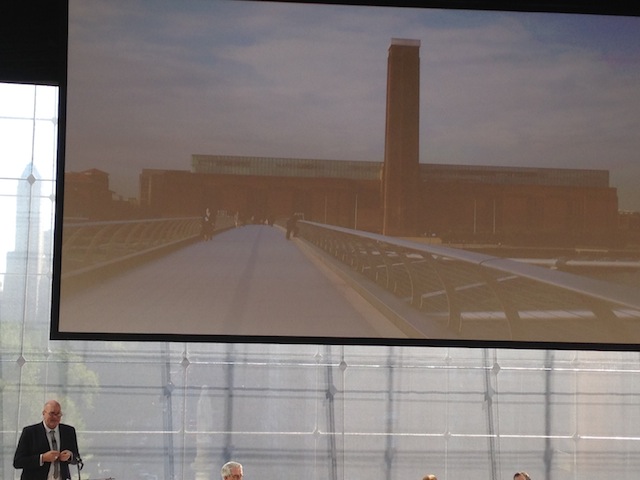
Jennifer Raab: Hunter thinks about who they are in the context of their neighborhood. During Sandy Hunter College opened a shelter. “As a public college we have given something valuable back to the community” in their restoration of the Roosevelt House. She explains that Hunter is taking community input into all of its new plans especially the new school of social work in Harlem.
Dr. Anthony W. Marx: “When people say the life of the mind is ending, come to the library. Every seat is filled. More books are circulating than ever… but in order to be a responsive anchor institution we have to continue to change. We have had a passive model for a century…we have to maintain the capacity for people to come in and use our quiet, our internet, our air conditioning… A quarter of NYC can’t afford books… We have to be proactive to meet educational needs in this town.” The NYPL launched after school pilots that will be the largest after school program in the nation. The 5 branches in the 5 poorest neighborhoods of NYC will have resources thrown at them. They will expand on homework help, free ESL, computer training. Also NYPL is now the library system for the NYC public school system. “We cannot sit tight. The world of libraries is changing in the most revolutionary possible way.”
Richard Olcott: Explains that the Yale Art Gallery after a 14-year renovation opened itself up to the community of New Haven. They want to bring people from “all walks of life into this incredible experience of art.” Also looks at the Boston WGBH building which reaches out to the community through radio, a giant changing screen on the highway, and the internet.
Jennifer Raab: Says that making a positive impact in the Harlem community is not just a hope but an imperative in the way they approach their project.
Donald Hyslop: It’s difficult to measure those types of positive impacts because they’re very abstract.
Dr. Marx: “I like non-quantitative metrics. I’ll feel better when I take the subway in the morning and people aren’t playing Angry Birds on their cellphones but rather reading.”
Richard Olctott: Accessibility is the really key thought… The Tate is free, the Roosevelt House is free… That makes a huge difference in creating openness… I don’t know how that works as a business model but it works for inclusiveness.
10:00am: New Ideas for the Next Administration
Sophia Koven (Introduction), MAS Director, President, Gambit Consulting; Carol Coletta (Moderator), VP, Community and National Initiatives, Knight Foundation; Greg Clark, Global Advisor on Cities; Alicia Glen, Managing Director, Goldman Sachs Urban Investment Group; Betsy Gotbaum, Former NYC Public Advocate; Edwin Torres, Associate Director, The Rockefeller Foundation
Moderator Carol Coletta: “What is the first thing you would do if you were the mayor of NYC?”
Greg Clark: “My first deed as the [hypothetical] mayor of NYC would be to create a regional government.” He says the “mosiac of governmental agencies” is slowing progress in NYC.
Betsy Gotbaum: We need someone who has a lot of power to make things happen.
Alicia Glen: It would be a good idea to have a one-stop-shop agency to figure out how to finance large-scale development. She says investors get frustrated with dealing with so many agencies to finance projects.
Edwin Torres: There needs to be greater borough to borough access which will have to be done with buses.
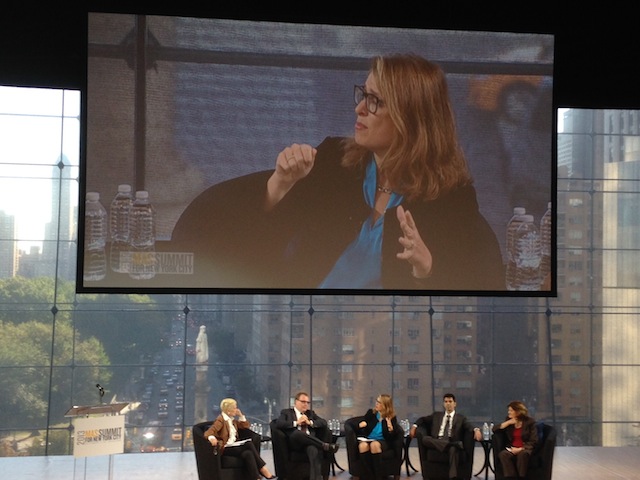
Betsy G: “The #1 thing is that the trains run on time, if you know what I mean.” She’s talking about livability.
Greg C: “I would get my regional government to work on the infrastructure of investing on affordable housing which would use a public-private partnership.” He looks at Singapore and Hong Kong as models. “The livability problem NYC has from the outside in… the rest of the world does not understand why health care does not understand why health care is not a public good.” (This gets a big clap from the audience.) He also think NYC needs to fix education.
Moderator Carol Coletta: How will NYC respond to the next climate event?
Betsy G: We need to look at what worked after Sandy. She cites Rockaway Surf Club as a community organization that was responsive and effective aft ccccccccccc er the storm.
Edwin T: This is the perfect time for infrastructure investment which could also create more jobs. Resilience happens on a NEIGHBORHOOD scale, this is hugely important. Coordination and support for community-based organizations.
Alicia G: Talks again about how leveraging more private capital will require streamlining municipal agencies.
9:46: KEYNOTE: Resilience Lessons From Unexpected Places: Rip Rapson, President and CEO of the Kresge Foundation
FIVE LESSONS:
1. “Building resilience requires viewing the present and future concurrently.” In Detroit Future City re imagines Detroit and looks at better use for all of its vacant land. The plan contemplates climate resilience. How will the city prepare to absorb people displaced by heat, drought, and flooding?
2. “Building resilience requires that we re-invent municipal governance models.” “What is the sweep of the problem shed and how will we align sources of knowledge accordingly?” Suggests that it would be smart to reach into many disciplines for answers in preparing for climate change.
3. Resilience is not an end state but rather an approach.
4. Residents are assets of essential knowledge, not victims to be cared for. Gives the examples of neighborhoods in heatwave that have low death rates even when they are comparably poor to neighborhoods with high death rates. What was different?
5. Resilience will be fleeting and ephemeral if it is not grounded in equity and inclusiveness. Low income residents should be involved in the creation and implementation of disaster preparedness measures. Distribution of cost and benefit should be transparent and fair.
Climate change will define the future of cities. “We must act today to avoid the unmanageable and the same time as we take action to manage the unavoidable.”
9:22: The Resilient Cities: Eugenie Birch (Introduction), Dr. Judith Rodin, President of the Rockefeller Foundation
Judith Rodin: “Sandy really changed how we in NYC prepare for the unexpected.” She gives examples of Rockefeller Foundation’s interest in the “what if” of a super-storm “We’ve been working with a visionary group in Jamaica Bay on a project that would protect more than 8,000 New Yorkers who call the estuary home.” “Post Sandy we have to be thinking about not just what-if but also what-now.” “Resilience is about the capacity of entire regions to prepare for, withstand, and emerge stronger from shocks and stresses… Resilience is no longer an option, it is truly an imperative… Between catastrophic storms, flooding, earthquakes, wildfires… because of Gobalization shocks spread quickly across the globe… with more than 3/4 of the planet expected to live in cities by 2050 these shocks will only continue to grow in impact unless we act now.”
“We have to ensure that momentum is not lost… and that the recommendations by all three commissions (Governor, City, Federal) are implemented….Cities are systems of systems.. they have the flexibility to evolve. We need de-networking at times…We need spare capacity….We must have the capacity for rapid rebound.”
She says that the building of resilience will require the funds and cooperation of the private sector. She suggests that the next disaster will probably be an extreme heat wave. “Our planning must not only recall 9/11 of fix what was broken by Sandy but prepare for a number of shocks…Many of these interventions help people’s daily lives even when there’s not a disaster.” It’s a “tripple win,” she says. The Rockefeller Foundation launched “100 Resilient Cities” which will provide resilience building support for 100 cities around the world.
“The world is watching now and learning from NYC. This really is our moment to lead the way.”
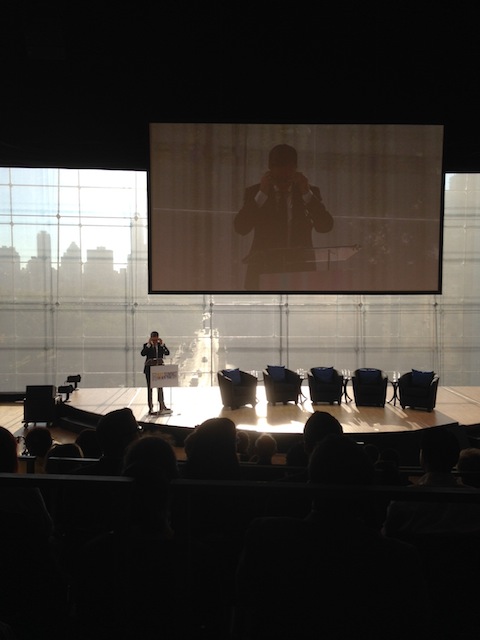
9:am Taking it Global: Stephen Huddart, Pres & CEO of the J.W. McConnell Family Foundation and Vin Cipolla, President MAS
Vin Cipolla: MAS wants to create a global learning network to promote resilience and livability by learning from other cities. MAS works to strengthen connections that create the dynamic cultural and economic mix that is “so so New York.” Civil society has a crucial leadership role in helping identify “effective, granular interventions to see how they can be scaled up” to promote livability and resilience.
Stephen Huddart: Jazz is a great metaphor for the work we are called to do. He shows photographs of Calgari this past June when it was completely flooded. “Calgari amazed the rest of Canada with how quickly it got back on its feet.” Explains that in Calgari the Mayor was inspiring and neighbors all helped each other rebuild the city. “Thousands and thousands of people were volunteering.” This is the short term and “we got it right”, but it’s much more difficult to plan for the long term. “We need to array ourselves around our problems” in order to innovate to solve them. He believes peer to peer networks are the best tool to do this. They provide the means by which thought and practice leaders to find each other. They allow for multi-sectoral collaborations. As examples: Innoweave, SVX: “Building the field of social finance”, Cities for People”The Resilience of Art. The Art of Resilience” is a paper on the topic that he invites everyone to google and read for more on this topic.





